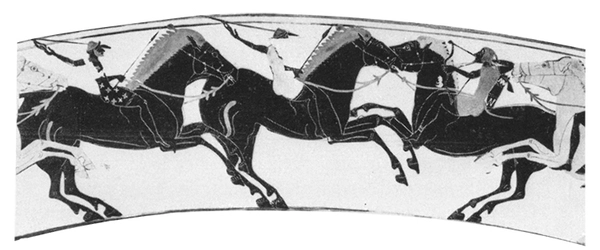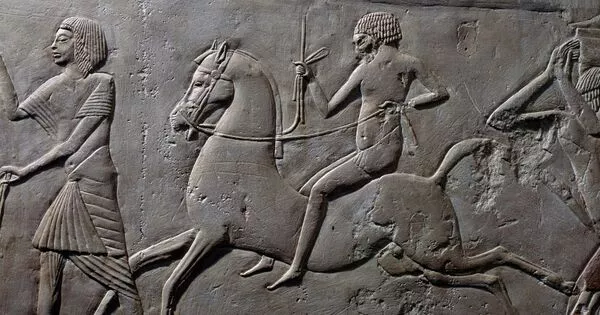The world’s earliest horse riders appeared in prehistoric periods, and the precise timeframe is difficult to determine due to a lack of written documents. Archaeological evidence, on the other hand, reveals that humans began domesticating and riding horses thousands of years ago. people and horses have had a relationship since the Neolithic period (approximately 4000-3500 BCE), when early people began to domesticate numerous animals. An international team of archaeologists and bioanthropologists has discovered the first evidence of horse riders.
The researchers discovered evidence of horse riding by analysing the remains of human corpses recovered in 4500-5000-year-old burial mounds known as kurgans. The Yamnaya civilisation was responsible for the earthen burial mounds. The Yamnayans had migrated from the Pontic-Caspian steppes to find greener pastures in today´s countries of Romania and Bulgaria up to Hungary and Serbia.
Yamnayans were mobile cattle and sheep herders, now believed to be on horseback.
“Horseback riding appears to have evolved not long after horses were thought to have been domesticated in the western Eurasian steppes during the fourth millennium BCE.” It was already very prevalent among Yamnaya culture members between 3000 and 2500 BCE,” says Volker Heyd, Professor of Archaeology at the University of Helsinki and member of the international team that produced the find.
Our research is now beginning to provide a more nuanced picture of their interactions. For example, findings of physical violence as expected are practically non-existent in the skeletal record so far.
Bianca Preda-Bălănică
These areas west of the Black Sea served as a crossroads for mobile groups of Yamnaya herders and the long-established agricultural communities of the Late Neolithic and Chalcolithic eras. For decades, the migration of steppe people into southern Europe during the Early Bronze Age was interpreted as a violent invasion. With the advent of ancient DNA research, the differences between these migrants from the East and members of local societies became even more pronounced.
“Our research is now beginning to provide a more nuanced picture of their interactions. For example, findings of physical violence as expected are practically non-existent in the skeletal record so far. We also start understanding the complex exchange processes in material culture and burial customs between newcomers and locals in the 200 years after their first contact,” explains Bianca Preda-Bălănică, another team member from the University of Helsinki.

Horse riding is a pivotal moment in human history
The employment of animals for transportation, particularly the horse, was a watershed moment in human history. The significant increase in mobility and distance has far-reaching consequences for land usage, trade, and conflict. The horses themselves have received the most of attention in recent research. However, horseback riding involves the interaction of two components: the mount and its rider, and human remains are more plentiful and in better form than early horse remains. Because horseback riding is possible without specialised equipment, the lack of archaeological findings pertaining to early horsemanship is not surprising.
Traces of horsemanship can be found in the skeletons
“We studied over 217 skeletons from 39 sites, about 150 of which were found in Yamnayan burial mounds.” It is difficult to diagnose activity patterns in human skeletons. There are no distinguishing characteristics that suggest a specific occupation or behaviour. Only when symptoms are combined as a syndrome do they provide reliable insights about prior habits,” explains Martin Trautmann, Bioanthropologist in Helsinki and lead author of the study.
The international team decided to use a set of six diagnostic criteria established as indicators of riding activity (the so-called “horsemanship syndrome”):
- Muscle attachment sites on pelvis and thigh bone (femur);
- Changes in the normally round shape of the hip sockets;
- Imprint marks caused by pressure of the acetabular rim on the neck of the femur;
- The diameter and form of the femur shaft;
- Vertebral degeneration caused by repeated vertical impact;
- Traumata that typically can be caused by falls, kicks or bites from horses.
The researchers also utilised a stronger filtering procedure and established a scoring system that takes into account the diagnostic value, distinctiveness, and reliability of each symptom to boost diagnostic reliability. Altogether, out of the 156 adult people of the total sample, at least 24 (15.4%) may be classed as ‘potential riders’, while five Yamnaya and two later as well as two possibly earlier individuals qualify as ‘very probable riders’. “The relatively high prevalence of these traits in the skeleton record, especially given the overall limited completeness, indicates that these people were horse riding on a regular basis,” Trautmann says.
If the primary use of horseback riding was as a convenience in a mobile pastoral lifestyle, in allowing a more effective herding of cattle, as means of swift and far-ranging raids or just as a symbol of status needs further research.
Could it all have happened even earlier?
“We have one intriguing burial in the series,” says David Anthony, emeritus Professor of Hartwick College USA and senior co-author of the paper.
“A grave dated around 4300 BCE at Csongrad-Kettöshalom in Hungary, long suspected to be an immigrant from the steppes based on its pose and artefacts, surprisingly showed four of the six riding pathologies, possibly indicating riding a millennium before Yamnaya.” A single occurrence cannot support a definite conclusion, but in Neolithic cemeteries of this age in the steppes, horse carcasses were occasionally interred among cattle and sheep, and stone maces were fashioned in the shape of horse heads. Clearly, we need to apply this strategy to even older collections.”
Who were the Yamnayans?
The Yamnayans were a people and culture that lived in the Pontic-Caspian steppes near the end of the fourth millennium BCE.
They were able to keep enormous herds of cattle and sheep by adopting the important innovation wheel and waggon, which allowed them to dramatically improve their mobility and harness a huge energy resource that was previously out of reach, the sea of steppe grass away from the rivers. Thus committing to a new way of life, these pastoralists, if not the world’s first real nomads, grew drastically over the next two centuries, covering more than 5000 kilometres between Hungary in the west and, in the form of the so-called Afanasievo culture, Mongolia and western China in the east. Having buried their dead in grave pits under big mounds, called kurgans, the Yamnayans are said to be the first to have spread proto-Indo-European languages.
















